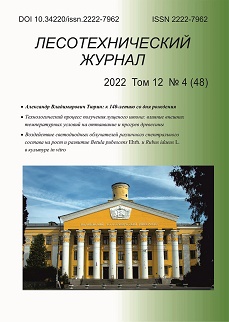Voronezh, Voronezh, Russian Federation
Russian Federation
Minsk, Belarus
To obtain high-quality peeled veneer, heating of wood is a mandatory technological operation. In winter, it is necessary to first thaw, and then warm up the wood to a certain temperature on the surface of the pencil. The operation of thawing and warming up is performed in open or closed water pools. One of the main factors of this technological operation is their duration. The available calculation formulas for employees of plywood enterprises are quite complex, since a number of values are selected from a large number of literary sources, and in the future, a number of parameters are calculated that determine the duration of thawing and heating of wood. In recent years, enterprises, in order to intensify the process of heating wood, are switching from open to closed pools. The results of the continuation of the TRP of wood in a closed water basin presented in the work will allow specialists to determine the desired time parameters without additional calculations. The results obtained showed that the determining factors for the duration of the TRP of wood in the production of plywood are not only the temperature of the air and the temperature of the water in the pool, but also the density of wood. Thus, for denser types of wood (birch, larch) used in the production of plywood, more time is required for thawing and heating. Moreover, the main heating of wood occurs at a pool water temperature of 60 °C, when thawing of wood occurs. After that, the duration of heating the wood to a temperature of 20 °C on the surface of the pencil is significantly reduced, especially at a pool water temperature of 80 °C.
peeled veneer, core (of veener), wood thawing, wood heating, duration, water pool, technological parameters
1. Erchiqui, F., Amorri, N. Heating time simulation for frozen Canadian wood species by 3D hybrid finite element enthalpy: aspen, white birch, yellow birch and sugar maple. Eur. J. Wood Prod. 80, 159-168 (2022). https://doi.org/10.1007/s00107-021-01749-4 EDN: https://elibrary.ru/GQVFJD
2. Mederski, P.S., Schweier, J., Đuka, A. et al. Mechanised Harvesting of Broadleaved Tree Species in Eu-rope. CurrForestryRep (2022). https://doi.org/10.1007/s40725-021-00154-7 EDN: https://elibrary.ru/IYMPIE
3. Araminienė, V., Dinca, L., Varnagirytė-Kabašinskiene, I. et al. Growth and chemical composition of sil-ver birch: Comparative study between Lithuania and Romania. J. For. Res. 32, 2111-2120 (2021). https://doi.org/10.1007/s11676-020-01231-6 EDN: https://elibrary.ru/VQRBNZ
4. Sokolova, E.G., Rusakov, D.S., Chubinsky, A.N. et al. A Study of the Properties of Melamine-Carbamide-Formaldehyde Resins Modified with Lignosulphonates. Polym. Sci. Ser. D 14, 508-512 (2021). https://doi.org/10.1134/S1995421221040213 EDN: https://elibrary.ru/XJFLCR
5. Wang, J., Cao, X. & Liu, H. A review of the long-term effects of humidity on the mechanical properties of wood and wood-based products. Eur. J. WoodProd. 79, 245-259 (2021). https://doi.org/10.1007/s00107-020-01623-9
6. Etuk, S.E., Agbasi, O.E. & Robert, U.W. Investigation of heat transfer and mechanical properties of Saccharum officinarum leaf board. Int J Energ Water Res 6, 95-102 (2022). https://doi.org/10.1007/s42108-021-00123-7
7. Ermilova A.I. Comparative studies of polymer materials for special pipes. 2017. Plastics, No. 11-12, pp. 48-51
8. Amiraslanova M.N. Synthesis of nitrogen-containing phenol-formaldehyde oligomers grafted with vege-table oils. 2017. Plastics, No. 3-4, pp. 28-32 EDN: https://elibrary.ru/YNDGHL
9. Lim DYS, Seo M-J, Yoo JC Optical temperature control unit and convolutional neural network for color-imetric detection of loop-mediated isothermal amplification on a lab-on-a-disk platform. Sensors 19(14):3207. (2019) https://doi.org/10.3390/s19143207 EDN: https://elibrary.ru/ORNDXG
10. Wang, J., Cao, X. & Liu, H. A review of the long-term effects of humidity on the mechanical properties of wood and wood-based products. Eur. J. Wood Prod. 79, 245-259 (2021). https://doi.org/10.1007/s00107-020-01623-9
11. Khattabi, A., Steinhagen, P. Analysis of transient nonlinear heat conduction in wood using finite-difference solutions. Holzals Roh-und Werkstoff 51, 272-278 (1993). https://doi.org/10.1007/BF02629373 EDN: https://elibrary.ru/AFULDS
12. Annasabi Z, Erchiqui F. 3D hybrid finite elements for anisotropic heat conduction in a multimaterial with multiple orientations of the thermal conductivity tensors. Int J Heat Mass Transf. (2020) https://doi.org/10.1016/j.ijheatmasstransfer.2020.119795
13. Erchiqui, F., Amorri, N. Heating time simulation for frozen Canadian wood species by 3D hybrid finite element enthalpy: aspen, white birch, yellow birch and sugar maple. Eur. J. Wood Prod.80, 159-168 (2022). https://doi.org/10.1007/s00107-021-01749-4 EDN: https://elibrary.ru/GQVFJD
14. Denaud L, Bléron L, Ratle A, Marchal R (2007) Online control of wood peeling process:acoustical and vibratory measurements of lathe checks frequency. Ann ForSci 64:569-575. https://doi.org/10.1051/forest:2007034
15. Denaud LE, Bléron L, Eyma F, Marchal R (2012) Wood peeling process monitoring: a comparison of signal processing methods to estimate veneer average lathe check frequency. Eur J Wood Prod 70:253-261. https://doi.org/10.1007/s00107-011-0549-8/ EDN: https://elibrary.ru/JZSANM
16. Gazizov A.M., Kuznetsova O.V., Garbovsky D.A. Ways to improve the preparation of raw materials for obtaining veneer Systems. Methods. Technologies. 2018. No. 3 (39). pp. 88-91. DOI: https://doi.org/10.18324/2077-5415-2018-3-88-91; EDN: https://elibrary.ru/YAUXJJ
17. Johannes Reiner, Sergio Orellana Pizarro, Kenny Hadi, Darren Narain, Peng Zhang, Matt Jennings, MahbubeSubhani,Damage resistance and open-hole strength of thin veneer laminates: Adopting design and test-ing principles from fibre-reinforced polymers, Engineering Failure Analysis, Volume 143, Part A, 2023, 106880,ISSN 1350-6307,https://doi.org/10.1016/j.engfailanal.2022.106880.
18. Anti Rohumaa, HeikkoKallakas, MarjaMäetalu, NataljaSavest, JaanKers,The effect of surface proper-ties on bond strength of birch, black alder, grey alder and aspen veneers // International Journal of Adhesion and Adhesives, Volume 110, 2021,102945,ISSN 0143-7496, https://doi.org/10.1016/j.ijadhadh.2021.102945.
19. Gilbert B. P. et al. Perpendicular to grain and shear mechanical properties of veneer-based elements glued from single veneer sheets recovered from three species of juvenile subtropical hardwood plantation logs //European Journal of Wood and Wood Products. - 2018. - T. 76. - №. 6. - P. 1637-1652. - DOI: https://doi.org/10.1007/s00107-018-1350-8. EDN: https://elibrary.ru/ODWMZG
20. Wang, T. In-plane mechanical properties of birch plywood / T. Wang, Y. Wang, R. Crocetti, M. Wålinder // Construction and Building Materials. - 2022. - Vol. 340. - P. 127852. DOI:https://doi.org/10.1016/j.conbuildmat.2022.127852. EDN: https://elibrary.ru/GRKXLB












